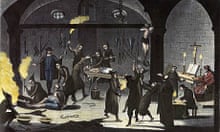In what appears to be an early application of art therapy, new research suggests that the Catalan architect Antoni Gaudí used the garden of a psychiatric hospital as a testing ground for his revolutionary designs, with the patients serving as his artisans.
The grounds of the hospital at Sant Boi, south of Barcelona, are littered with Gaudí-esque constructions, the most outstanding of which is a bench similar to those in Park Güell , finished with broken tiles in a style known as trencadís that was pioneered by Gaudí.
The relative crudeness of the work suggested until now that the works were copies, but research published in the magazine Sapiens by the architect David Agulló and the geologist Daniel Barbé shows that they pre-date Gaudí's signature buildings and were in fact prototypes for features in Park Güell, the Sagrada Familia and the nearby Colònia Güell, all of which Gaudí was working on at the time.
The work is poorly executed, the researchers claim, because Gaudí's workers were in fact patients. The bench at the hospital dates from 1912, while that at Park Güell was made in 1914. A further link with Gaudí is that his patron, Eusebi Güell, was closely associated with the management of the hospital and at one point provided one of his houses as an isolation ward during a cholera outbreak at the hospital.
The Sant Boi hospital was founded by the widely travelled doctor Antoni Pujadas in 1854. It was the first hospital in Spain to treat mental illness as something other than divine punishment or demonic possession. Pujadas was an advocate of ergotherapy, which treats illness through physical activity, in particular through manual work. He was also in contact with the French psychiatrist August Marie, an early advocate of art therapy, who was a regular contributor to the Sant Boi hospital's journal.
While Gaudí was part of the art nouveau movement – or modernisme, as it's known in Catalunya – he was also a revolutionary structural engineer. He made an upside-down model of the Sagrada Familia to test his structural theory, which he then tested in practice when he built Colònia Güell. "Without that first trial, I'd never have dared adopt the design for the temple," he said. It now appears that it began earlier still, as an experiment in both architecture and psychiatry, in the gardens of the hospital at Sant Boi.



